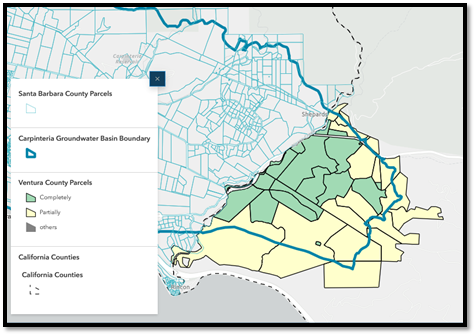Written by: Robert McDonald, Executive Director of the CGSA
Throughout California, groundwater sustainability agencies (GSAs) are working on developing policies and programs that will allow for their groundwater basins to meet the state’s requirements outlined in the Sustainable Groundwater Management Act (SGMA). SGMA was passed in 2014 to encourage the local management of groundwater basins to help protect this critical water source over the long-term.

Figure 1. Map showing Ventura County parcels completely within the CGB boundary and parcels partially within the CGB boundary
The Carpinteria Groundwater Sustainability Agency (CGSA) was formed in 2020 after the Carpinteria Groundwater Basin (CGB) was designated as a high-priority basin by the state. We submitted our Groundwater Sustainability Plan (GSP) to the Department of Water Resources (DWR) at the beginning of this year outlining how the CGSA and local stakeholders will ensure groundwater reliability within 20 years. DWR has two years to respond and comment on the GSP. The CGSA operated under loans from Carpinteria Valley Water District (CVWD) in its first two years and then began collecting fees directly from property owners after a fee study was conducted in 2022. In fiscal years 2023 and 2024, these fees were collected as direct charges on property tax statements and were based on property acreage overlying the CGB. Properties in both Santa Barbara County and Ventura County overlying the CGB were impacted, and the fees were proportional to the parcel’s acreage overlying the basin. For example, if the parcel was completely within the groundwater basin’s boundary it was charged the per-acre fee for the entirety of its acreage (as shown in green in Figure 1); however, if it was only partially overlying the CGB (as shown in yellow in Figure 1) it was only charged for the acreage within the basin’s limits.
This spring, in response to community feedback highlighting that only groundwater users should be responsible for CGSA fees, the Board of Directors authorized staff to develop a method for implementing a charge based on estimated groundwater pumping. This method utilizes crop modeling and crop water demand factors to estimate groundwater use. The estimates for groundwater pumping are based on the trailing year’s data: Fiscal Year 2025 is based on estimated pumping from Fiscal Year 2022, while Fiscal Year 2026 is based on estimated pumping from Fiscal Year 2023.
Property owners who had groundwater pumping estimates calculated for their properties were contacted by mail in the fall of 2023 with crop maps and estimated groundwater pumping calculations provided to them. Property owners were given an opportunity to present additional data to the CGSA to have these calculations revised. A fee of $79.00 per acre-foot of groundwater has been adopted for fiscal years 2025 and 2026 fees and the fees will continue to be collected as direct charges on property tax statements. Carpinteria Valley Water District (CVWD) is also subject to these fees and will pay their share. All CVWD production wells are metered and the District will be billed in fiscal year 2025 for the 1,977.04 acre-feet of groundwater that were pumped in fiscal year 2022. The District will be billed in fiscal year 2026 for the 1,291.30 acre-feet that were pumped in fiscal year 2023.
Although the current crop modeling and groundwater estimates represent the first step toward having groundwater users solely pay for CGSA fees, there is a general consensus among property owners that more data is needed to refine the estimates. The current crop model uses a locally derived average water application per crop type (acre-feet of water per acre of crop), excluding both extreme high and low users from the average. However, many property owners who have implemented water-saving measures to reduce their water use per acre are concerned about being charged the same as properties across the basin that use more water per acre with less efficient systems. In response, the CGSA has explored alternative models that incorporate rainfall, evapotranspiration, and delivered water, and has recently examined how other GSAs and groundwater management agencies (GMAs) have implemented metering programs.
In our research, it became evident that many private well metering programs in California are already well-established, and metering programs appear to be the future for groundwater sustainability management. Private well metering programs appear to be an equitable way to assess CGSA fees so that groundwater users are charged proportionally to their measured groundwater use. A metering program would also have the benefit of allowing the CGSA to precisely measure and report known groundwater extractions to DWR in our annual reports and more accurately monitor total groundwater extraction by CVWD and private groundwater users on an annual basis. Many groundwater agencies in neighboring Ventura County have already established private well metering programs that can provide the CGSA with guidance as this option is pursued and a local metering program is explored. The CGSA is working to outline a program framework this fall and winter and will be exploring various funding and reporting options. IF the CGSA Board authorizes a metering program, the CGSA Staff anticipates implementing a metering policy by the end of 2025. Stakeholder involvement is a priority as we develop the program, and we encourage all groundwater users in the Carpinteria Valley to get involved and share their input with CGSA staff and Board of Directors.
Letters and maps of estimated fiscal year 2023 groundwater pumping, which will be used for fiscal year 2026 fees, will be mailed out to property owners this fall. Owners will, once again, be given an opportunity to provide supplemental information to the CGSA. For more information about the CGSA, please visit carpgsa.org and sign up for e-mail updates. If you have any questions related to SGMA or the CGSA, please contact sgma@cvwd.net.